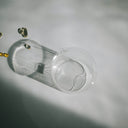Hair loss is a concern that affects millions worldwide, often sparking questions about its connection to hormones—particularly testosterone. Many people assume that high testosterone levels directly cause baldness, pointing to stereotypes of muscular, bald men as "proof." But is there scientific truth behind this idea? In this article, we’ll explore the complex relationship between testosterone and hair loss, separating myths from facts and providing actionable insights for those seeking answers.
Table of content
Can High Testosterone Cause Hair Loss?
Yes, high testosterone can contribute to hair loss, but not directly. The real culprit is dihydrotestosterone (DHT), a hormone derived from testosterone. Individuals with a genetic sensitivity to DHT may experience hair follicle shrinkage, leading to male or female pattern baldness. While testosterone levels play a role, genetics and hormonal balance are the primary factors determining whether high testosterone leads to hair loss.
As your leading source for hair health information over the past 4 years, we never compromise on accuracy. When it comes to your health, you deserve information you can truly rely on - and earning your trust is our top priority.
Here's how Scandinavian Biolabs ensures every piece of content meets the highest standards of accuracy and integrity:
- Credentialed Experts: Our reviewers are actively practicing doctors and medical researchers
- Stringent Reviews: Content undergoes rigorous editing by subject specialists and review by a practicing doctor.
- Evidence-Based: We rely on well-established research from trusted scientific sources like peer-reviewed journals and health authorities.
- Full Transparency: Our editorial standards, writer credentials, reviewer credentials, correction process, and funding are all publicly documented.
- Independent Voice: While we do promote products, we operate in a vacuum to business operations. Our main goal is just an unwavering commitment to providing medically-sound guidance.
You can count on Scandinavian Biolabs to consistently deliver the trustworthy health information you deserve. Read our Editorial Standards.
The Role of Testosterone in the Body
Testosterone is a vital hormone in both men and women, responsible for muscle growth, bone density, libido, and overall energy. However, its relationship with hair loss is often misunderstood.
How Testosterone Converts to DHT
Testosterone converts to DHT via the enzyme 5-alpha reductase. DHT binds to receptors in hair follicles, particularly those on the scalp, and shortens the hair growth cycle. Over time, follicles miniaturize, producing thinner, shorter hairs until they stop growing altogether.
Genetic Sensitivity to DHT
Not everyone with high testosterone or DHT loses hair. Genetic predisposition determines whether follicles are vulnerable. For example, if your family has a history of androgenetic alopecia (pattern baldness), you’re more likely to experience DHT-driven hair loss.
Does High Testosterone Directly Cause Hair Loss?
While high testosterone increases DHT production, research shows that blood testosterone levels alone don’t predict baldness. Studies comparing bald men to those with full hair found similar testosterone levels in both groups. Instead, genetic sensitivity to DHT and follicle receptor density are stronger predictors.
Key Studies and Findings
- A 2012 study in the Journal of Clinical Endocrinology & Metabolism found no significant difference in testosterone levels between men with male pattern hair loss (MPHL) and those without.
- Research in PLOS Genetics identified over 250 genetic markers linked to androgenetic alopecia, highlighting the role of heredity.
Exceptions: When High Testosterone Accelerates Hair Loss
In rare cases, extremely high testosterone (e.g., due to steroid use or tumors) can exacerbate hair loss in genetically predisposed individuals. Conditions like polycystic ovary syndrome (PCOS) in women also elevate testosterone and DHT, often triggering hair thinning.
Risk Factors for Testosterone-Related Hair Loss
Understanding your risk profile can help you take preventive steps. Key factors include:
1. Genetics
Family history is the strongest predictor. If parents or grandparents had pattern baldness, you’re more likely to experience it, regardless of testosterone levels.
2. Age
DHT sensitivity increases with age. Hair loss often begins in the 30s-40s as hormonal shifts and cumulative DHT exposure take effect.
3. Hormonal Imbalances
Conditions like PCOS, thyroid disorders, or adrenal hyperplasia disrupt hormone levels, raising DHT and accelerating hair loss.
4. Lifestyle Factors
Poor diet, chronic stress, and smoking can increase inflammation and oxidative stress, worsening follicle sensitivity to DHT.
Signs of Testosterone-Related Hair Loss
Recognizing early symptoms allows for timely intervention. Look for:
- Receding Hairline: A classic sign of male pattern baldness, starting at the temples.
- Thinning Crown: Hair loss concentrated at the top of the head.
- Diffuse Thinning: Overall reduction in hair density, common in women.
Managing and Preventing Hair Loss Linked to Testosterone
While you can’t change your genetics, these strategies can slow or mitigate hair loss:
1. Medications
- Finasteride: Blocks 5-alpha reductase, reducing DHT production.
- Minoxidil: Stimulates blood flow to follicles, promoting regrowth.
2. Lifestyle Adjustments
- Balanced Diet: Prioritize iron, zinc, biotin, and omega-3s to support hair health.
- Stress Management: Practice yoga or meditation to lower cortisol, which can worsen hormonal imbalances.
3. Hair Care Practices
- Avoid tight hairstyles and excessive heat styling.
- Use gentle, sulfate-free shampoos to minimize scalp irritation.
4. Medical Procedures
- Platelet-Rich Plasma (PRP) Therapy: Uses growth factors to revive dormant follicles.
- Hair Transplants: Surgically relocates DHT-resistant follicles to thinning areas.
Debunking Myths About Testosterone and Hair Loss
Myth 1: "Bald Men Have Higher Testosterone"
No conclusive evidence supports this. Baldness correlates with genetic sensitivity, not hormone levels.
Myth 2: "Lowering Testosterone Prevents Hair Loss"
Artificially reducing testosterone can cause side effects like fatigue and low libido. Targeted DHT blockers are safer and more effective.
When to See a Doctor
Consult a dermatologist or endocrinologist if:
- Hair loss is sudden or patchy (may indicate autoimmune issues).
- You experience other symptoms like acne, irregular periods, or weight gain.
Conclusion
High testosterone alone doesn’t cause hair loss—genetics and DHT sensitivity are the primary drivers. While you can’t change your DNA, early intervention with medications, lifestyle changes, and advanced treatments can help preserve your hair. Always consult a healthcare provider to tailor a plan to your unique needs.
Tired of Thinning Hair? Try a Clinically Tested Serum.
Looking for a natural way to regrow hair and achieve a thicker, fuller head of hair? Ditch the stinging nettle for hair loss – Bio-Pilixin Serum is a drug-free hair activation serum that delivers clinically tested results.
Here's why Bio-Pilixin is superior:
- Clinically Tested Results: 93% of users saw a reduction in hair loss, and 73% experienced increased hair density.
- Safe and Natural: Unlike harsh chemicals, Bio-Pilixin uses plant growth factors derived from stem cell technology to nourish hair follicles and stimulate growth.
- Fast-Acting: See visible results in as little as 45 days (most typically see results within 150 days).
Stop wasting time on unproven remedies. Bio-Pilixin is the safe, natural serum you've been searching for.
Read more:






